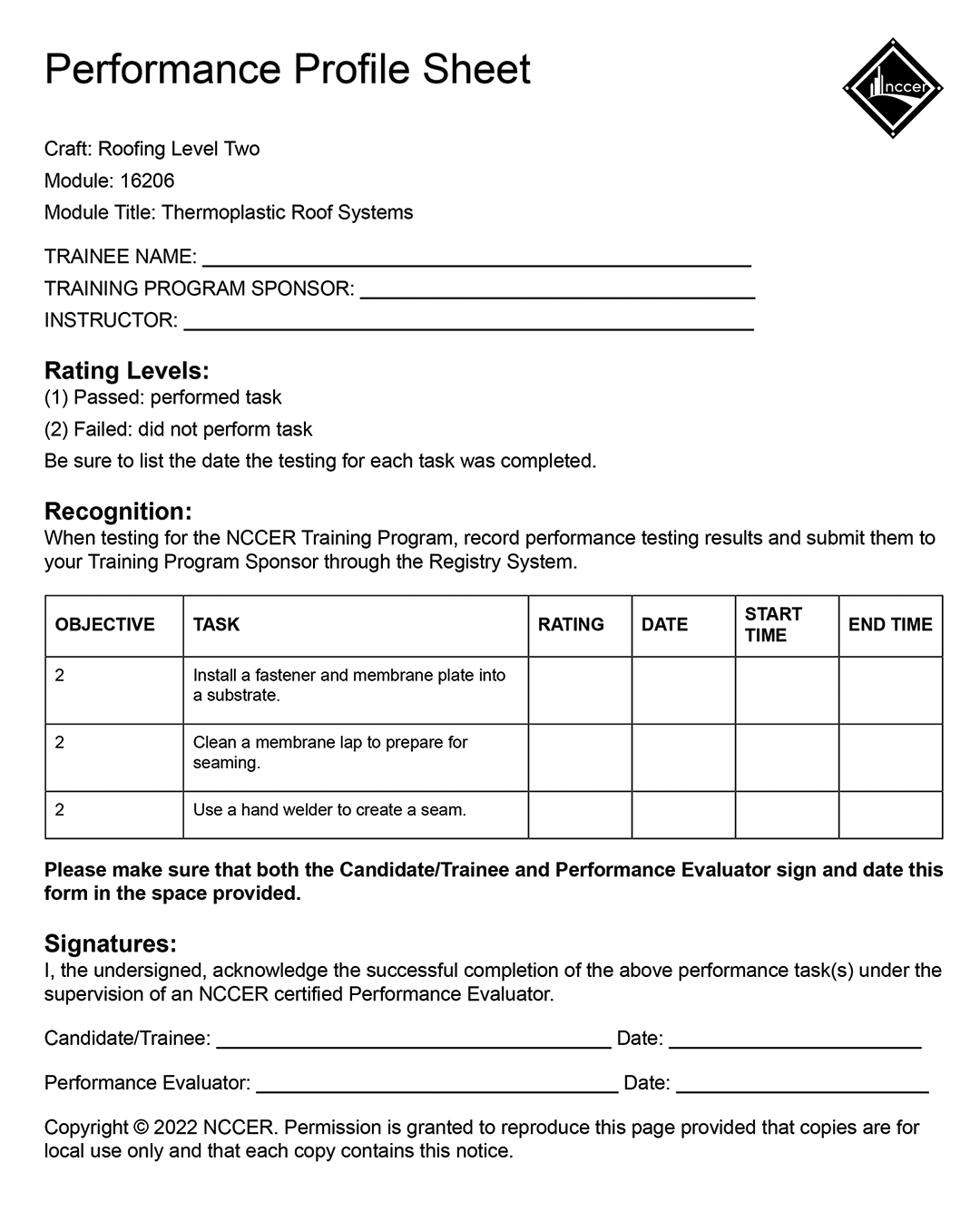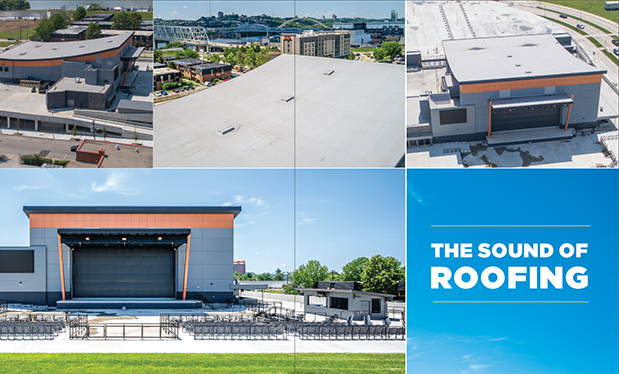“Do you have a curriculum you can recommend for my local trade school so it can start a roofing program?”
“We’re starting an apprenticeship program and need a curriculum; do you have something we can use?”
“I’ve been working with the community college in my town and they’re willing to let me teach a class; can I get a plan and materials?”
NRCA has been asked these questions (and many others) from roofing professionals over the years. NRCA staff usually would respond by outlining comprehensive programs and suggesting resources, but developing a complete curriculum had not been feasible.
However, in 2019, the National Center for Construction Education & Research, a nonprofit educational foundation affiliated with the M.E. Rinker Sr. School of Building Construction at the University of Florida, Gainesville, presented a partnership proposal to develop such a curriculum. NCCER is a well-established organization with training for more than 70 trades. Although NCCER had a roofing curriculum, it only addressed asphalt shingle roof systems.
During the past two years, NCCER and NRCA members and staff have met with roofing subject matter experts to create a comprehensive roofing curriculum related to all major roof systems installed in the U.S. A new opportunity for training roofing employees now is in the works.
NCCER Roofing Curriculum
The new materials include textbooks, instructor notes, slide decks and tests for all three parts of the curriculum: Core, Level 1 and Level 2.
Core is relevant to construction in general. Level 1 modules are designed to be completed in about 180 hours and address general roofing topics. These modules primarily are knowledge-based; only a few include performance requirements. Level 2 modules will be system-specific, and each includes performance tasks. The Level 2 curriculum is in final stages of development, but the total hours are estimated to be between 160 and 185 hours, satisfying apprenticeship requirements.
Following are modules within each package:
Core
- Basic safety
- Introduction to construction math
- Introduction to hand tools
- Introduction to power tools
- Introduction to construction drawings
- Introduction to basic rigging
- Basic communication skills
- Basic employability skills
- Introduction to material handling
Level 1
- Introduction to roofing
- Roofing safety*
- Fall-protection orientation
- Drawings in roofing
- Introduction to steep-slope roofing
- Introduction to low-slope roofing
- Substrates, decks and roof insulation*
- Sheet metal in roofing*
- Rigging practices*
*Denotes included performance requirements
Level 2
- Asphalt shingle roof systems
- Clay and concrete tile
- Wood shakes and shingles
- Slate
- Metal panel and metal shingles
- Thermoplastic roof systems
- EPDM roof systems
- Built-up roof systems
- Polymer-modified bitumen roof systems
- Liquid-applied roof systems
- Spray polyurethane foam roof systems
- Service and repair
Natalie Hasty, a team member and NCCER technical writer, says:
“I think one of the most striking things about writing the roofing curriculum is how much history, culture and science has gone into the industry to make it what it is today. Whether we think about roofing on a basic level or hyper-technically, there are years of information and adaptation impacting our perceptions. Even the earliest human beings had to consider a roof over their heads—that’s how rich of a history this craft has.
“Another exciting aspect of learning this trade is how much the knowledge gathered is immediately relevant. There is nothing like getting a visual representation of course fundamentals while driving through a neighborhood or to a grocery store.”
The new, roofing-specific Level 1 curriculum is complete and available, and Level 2 will arrive in Spring 2022.
Performance requirements
Hands-on training is essential for any construction-related program. As mentioned, some Level 1 programs include hands-on performance requirements, as do all Level 2 programs (see the figure). In this case, there are three tasks a trainer should observe from each participant to satisfy module requirements. These may be completed in a shop, training center or on a job site.
Who can teach the curriculum?
Anyone can teach the NCCER curriculum. Access is unrestricted and can be purchased from Pearson, an education publishing company that coincidentally grew out of a British construction company formed in the 1840s.
Although anyone can purchase the curriculum and teach it, participants must complete their training within the NCCER Registry system to earn NCCER credentials.
The NCCER Registry
Two main aspects of the NCCER Registry are benefits and requirements.
Benefits
When your organization is part of the NCCER Registry, participants’ accomplishments will be recorded in a national registry so their training and accomplishments can be verified throughout their careers. Participants will receive credentials—showcased through digital badges—for each module they successfully complete. They also can earn a low- or steep-slope roofer credential when they complete modules required for those designations.
These benefits, though direct to participants, also are good for organizations. Roofing companies can track and tout their employee training, which is helpful for internal record keeping and marketing to potential customers. Trade schools, community colleges and other programs also can lean into this data to demonstrate success stories. High school students, particularly those in technology programs, value accumulated credentials and will be attracted to programs that offer such opportunities.
Requirements
Organizations that want participants to be part of the NCCER Registry must be Accredited Training Sponsors and have certified Craft Instructors. According to NCCER’s website, nccer.org: “A Craft Instructor is an individual who has successfully completed the Instructor Certification Training Program (ICTP) conducted by an NCCER Master Trainer with current credentials and is authorized to teach the NCCER curriculum. Craft Instructors must meet the following qualifications: Experience at a minimum journey or technician level in their area of expertise OR a minimum of three years’ experience as a certified teacher in a vocational/technical construction or maintenance-related training program.”
More information about the processes of becoming an Accredited Training Sponsor and Craft Instructor and thereby being part of the NCCER Registry can be found on the NCCER website or by contacting John Esbenshade, NRCA’s director of workforce development, at jesbenshade@nrca.net.
Will this lead to NRCA ProCertification®?
The NCCER curriculum was developed with an installer’s career path in mind, beginning with education and ending with certification. The breadth of the curriculum was designed and intended to help prepare an individual to pass NRCA's ProCertification exams.
NRCA's ProCertification exams are not related to the NCCER curriculum; however, individuals will learn and practice the skills necessary to install various roof systems. To be truly proficient, of course, requires practice over time. Organization of the modules assumes a passage of time and skills development.
 An example of hands-on performance requirements from the thermoplastic roof systems module An example of hands-on performance requirements from the thermoplastic roof systems module
|
For example, the asphalt shingles module does not require participants begin with roofing experience beyond completion of the Level 1 curriculum. But one of the course objectives is for participants to be able to “apply underlayment and an asphalt shingle covering to a wood deck.” Clearly, some time and practice are required with various skills before this objective can be completed.
To pass an NRCA ProCertification exam, participants must be able to complete these skills according to specific certification requirements and within certain time parameters, so completing the NCCER module is not a guarantee one is prepared to get certified; however, it provides more than the basic information.
Comparing curricula
Roofing professionals familiar with NRCA’s Training for Roof Application Careers may wonder how or whether these programs work together. Both are designed for novice installers, but that is where the similarities end. Organizations need to know what they want and how they want to accomplish it.
The NCCER curriculum is to be used within structured, classroom-based settings, such as community colleges, trade schools, high schools and apprenticeship programs. NRCA created TRAC for roofing companies looking to efficiently onboard and retain new and inexperienced workers, which is the reason it is an inexpensive, one-time purchase.
The knowledge aspects of the NCCER curriculum are classroom-based and taught in person by an instructor. The knowledge aspects of TRAC are accomplished online and usually self-paced.
TRAC’s hands-on requirements are meant to be conducted in short sessions in a shop and are not as encompassing as NCCER performance requirements.
NCCER’s goal is for participants to complete an apprentice-level program and become fully equipped roof system installers. TRAC takes a fraction of the time and is intended to take a brand-new employee to a level of conversational competence rather than installation proficiency. To use a swimming analogy, TRAC is designed to help people feel comfortable in the water as they learn basic strokes, and NCCER enables them to be able to join a swim team.
The NCCER curriculum requires a trainer for all aspects of training; TRAC does not. However, TRAC online content will be best accomplished with some level of accountability. Both systems need someone to facilitate and sign off on the hands-on aspects of the programs.
Dedicated trainers
Regardless of your training program of choice, a company without a dedicated trainer is going to struggle to maintain any level of intentional, quality training. Even TRAC will falter if no one at your company follows up with employees.
If you do not have someone at your company in this role, a good first step is to identify someone who exhibits patience, good communication skills and enjoys interacting with people. A trainer to teach the NCCER curriculum or the hands-on skills in either program must have roofing experience and expertise, but someone who will fill a role of setting up training or tracking it may be an office administrator or human resources professional.
Dedicated does not necessarily mean full-time though NRCA encourages companies to consider the value of a full-time role. Whether a company needs a full-time trainer depends on its curriculum and the volume of employees who will be engaging with it.
An effective way of determining who at your company would be suited to this role is sending one or more of your employees to an NRCA Qualified Trainer conference, a two-day virtual or live course designed to help roofing professionals become effective training professionals. Participants learn how to execute training and maintain the training function at a company.
A game-changer
NRCA is excited about the training potential in the roofing industry. For too long, “we do on-the-job training” has meant “we hire people and put them on job sites where we hope foremen will keep them busy and teach them something.” Obviously, this is not a good method of training, much less attracting and retaining, a younger workforce. TRAC is one step toward retaining employees in the industry, and the NCCER curriculum is a game-changer for trade schools, apprenticeship programs and other classroom-based settings.
AMY STASKA is vice president of NRCA University.


